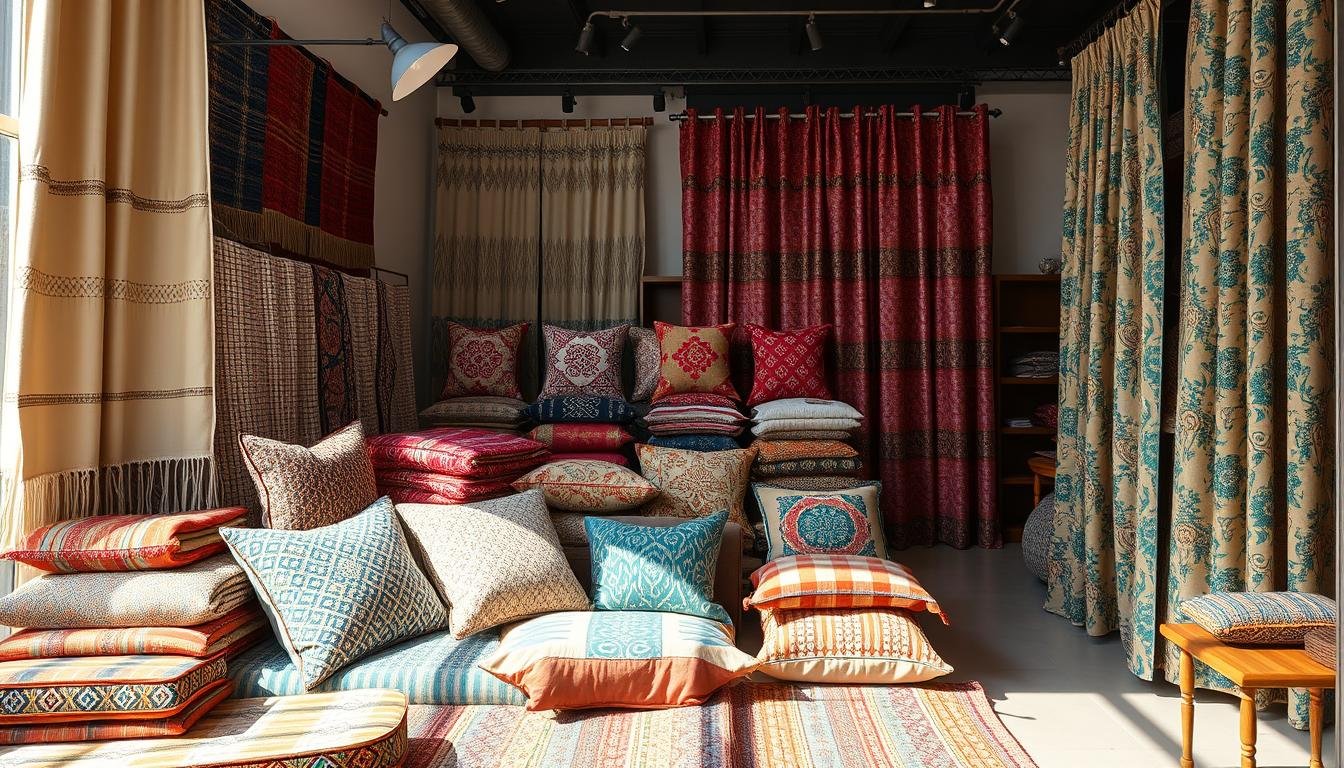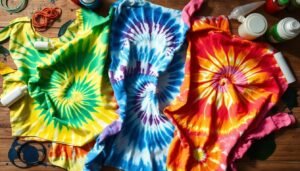Did you know the global home textile market was worth USD 119.09 billion in 2022? It’s expected to jump to USD 196.13 billion by 2031, growing at 5.7% each year from 2024 to 20311. This shows how big and fast the retail home textiles market is getting.
Now, technology and changing tastes are making home decor trends exciting. Companies like Beytown Textile are at the forefront. They offer new and traditional home textiles. This mix shows how home textiles are changing and looks promising for the future.
Key Takeaways
- The global home textile market is projected to grow significantly over the next decade.
- Innovations in technology play a crucial role in shaping consumer preferences.
- Beytown Textile exemplifies the progress in modern and traditional textiles.
- Consumers increasingly see textiles as an integral part of their home aesthetics.
- Online retail is becoming a significant driver of market growth.
Overview of the Home Textile Market
The home textile market is big, covering things like bed linen, curtains, towels, and upholstery. In 2023, it was worth about USD 126.12 billion. By 2032, it’s expected to hit USD 211.27 billion, growing at 5.9% each year2. Big names like Trident Group, Welspun India Ltd, and IKEA play big roles in the market2.
Now, there’s a big move towards eco-friendly home decor because of what people want3. More people living in cities and new homes mean more need for stylish, useful textiles2. But, competition and high prices might make things harder for buyers3.
The US market for home textiles is set to grow by USD 6.31 billion from 2023 to 2028, at a 5.17% annual growth rate3. Bedroom linen is expected to be the biggest part of the market, showing how textiles are key in home design3.
Current Market Size and Growth Projections
The home textile industry is growing fast, with a market size of USD 124.72 billion in 2023. This growth is thanks to more people spending on home improvements and a strong housing market. By 2030, the industry is expected to reach USD 179.87 billion, growing at a 5.20% annual rate4.
In the United States, the home textile market was worth about USD 19.14 billion in 2023. It’s expected to grow even more, with a 4.7% annual growth rate until 2030. This is because more people want products like bed and bath linens5.
Bedroom linens made up 45.14% of the U.S. market in 2023. Polyester textiles were a big part, with 37.7% of the market. Online sales of home textiles in the U.S. are also expected to grow fast, at a 6% annual rate from 2024 to 20305.
Technology is changing home textiles, making smart products popular. The focus on sustainable materials will shape the market’s future. Companies like Beytown Textile are adapting and innovating in this changing market in this rapidly evolving landscape. The market is expected to grow to USD 134.13 billion by 2024 and USD 175.64 billion by 2029. This shows the need for companies to keep up with trends to stay ahead in the home textile industry4 and6.
Understanding Consumer Preferences in Home Textiles
Today, people want home textiles that match their lifestyle and style. They look for products that make their homes better and reflect their unique taste. In 2013, Americans spent $42.6 billion on home textiles, showing a strong market7. This spending is expected to grow by 2-3% each year until 20207.
People want items that last a long time, especially for bedding and sheets. These make up about a quarter of home textile sales in the U.S7..
Influence of Lifestyle and Personal Aesthetics
Now, many choose home textiles that show off their personal style. A big 72% of people now see a comfy home as more important than before the pandemic8. This shows how important comfort and style are for a cozy home.
Reviews of over 48,000 customers show that many feel their needs aren’t met by what’s available7.
Shifting Priorities Towards Sustainable Choices
More people now think about sustainability when buying home textiles. In 2017, 45% did, but now it’s 55%8. Cotton is still the top choice for many, as it’s seen as the best material for home textiles7.
But, many don’t know what “circularity” means, which could affect their choices8. As demand for eco-friendly textiles grows, brands like Beytown Textile need to be clear about where they get their materials and keep quality high.

Retail Home Textiles: Trends in Modern Markets
The world of home textiles is changing fast. It’s shaped by new fabrics, smart textiles, and online shopping growth. Brands like Beytown Textile lead with new products and tech.
Innovations in Design and Fabric Technology
Home textiles now have exciting designs and materials. These make them more useful and look better. The market for home decor textiles is set to hit USD 85.66 Billion in 2023. This shows how important new ideas are for meeting what customers want9.
Rise of Smart Textiles in Home Decor
Smart textiles are changing home decor with new tech. They make things more useful and comfy. By 2029, this market is expected to grow to USD 109.21 Billion, showing a 4.13% annual growth9.
The Impact of E-commerce on Home Textiles Sales
Online shopping has changed how we buy home textiles. Now, we can find many products easily from home. Online stores are key to the market’s growth, expected to reach US$ 195.3 Billion by 203210. This change means old stores need to adapt to stay competitive.
Revival of Traditional Home Textiles
Traditional home textiles are coming back in style. People love vintage designs and heritage textiles again. Companies like Beytown Textile lead this trend. They mix old-world skills with new uses to attract those who want something real and nostalgic.
Popularity of Vintage and Heritage Designs
The ikat weaving technique is getting more popular, with a 20% increase in demand11. Artisans in Mexico are seeing a 25% jump in orders for their unique textiles11. This growth is thanks to sustainable fashion and the mix of old and new skills12.
Blending Traditional Techniques with Modern Applications
Companies are using old weaving ways with new designs to attract buyers. In India, block printing sales have doubled thanks to eco-friendly and modern styles11. Handmade textiles stand out because each one is special, unlike mass-produced items12. This approach is making traditional textiles popular again. It also helps local communities by giving artisans good work and fair pay12.
Material Insights: Which Fabrics Dominate the Market?
Home textiles are shaped by different fabrics like cotton and polyester. These fabrics have unique qualities. Knowing about them helps people choose better for their homes. Cotton is loved for being soft and breathable. Polyester is known for being durable and easy to care for.
Cotton vs Polyester: Pros and Cons
Cotton is a natural fiber that’s comfy and good at soaking up moisture. It’s perfect for bedding and curtains. Polyester, being synthetic, dries fast and doesn’t wrinkle much. It was about 39% of the market in 2023 and might be 40% by 203213.
Both fabrics are key in many products. The bedroom linen market made about USD 50 billion in 2023. This shows people really like their bedding14.
The Growth of Eco-Friendly Fabrics
More people want eco-friendly textiles now. Brands like Beytown Textile use recycled fibers and organic cotton. This meets the demand for sustainable products.
Manufacturers are making more sustainable options. These products look good and help the planet. People are choosing sustainable textiles more often for their homes like these versatile alternatives like viscose

The industry is changing. Using these fabrics will make shopping better for everyone. It will match what people value and need1413.
The Role of Distribution Channels in Home Textiles
The home textiles market is shaped by its distribution channels. These channels help move goods from makers to buyers. Companies now focus on improving their sales strategies. They need to understand the balance between selling in stores and online.
Offline Sales vs Online Sales Dynamics
In 2023, most home textiles were sold offline, making up over 65% of the market. Stores like supermarkets and special shops are key players. They let customers touch and feel the products before buying15. But, more people are buying online now. This change helps brands like Beytown Textile reach more people and save money16.
Importance of Supermarkets and Specialized Retailers
Supermarkets and special stores are vital in the home textiles market. They offer a wide range of products for different customers. Big European retailers are now buying directly from suppliers in other countries. This makes the supply chain shorter and prices lower15.
Small shops are starting to buy directly from makers too. This cuts costs and boosts profits. It also makes the market more competitive. Now, customers can find a wide variety of home textiles at various prices.
Regional Insights: Home Textiles Market in the United States
The US home textiles market is a big deal worldwide. It’s shaped by different consumer tastes across regions. As more people move to cities, big companies are making plans to meet new needs and wants.
Key Regional Players and Market Strategy
In 2024, the US home textiles market is expected to hit USD 23.78 billion. This is up from USD 22.56 billion in 2023. By 2029, it’s set to reach USD 30.96 billion, growing at a 5.42% annual rate17. Big names like Milliken, Mohawk Industries, Welspun Group, WestPoint Home, and Shaw Industries lead the market. They aim to keep their strong market share while offering new products that people want.
Urbanization and Its Impact on Home Textiles Demand
More people moving to cities means more homes and more spending on textiles. This is thanks to more money and a focus on making homes look nice17. But, companies face challenges like tough competition and supply chain issues. They need to quickly adjust to stay ahead.
Challenges Faced by the Home Textiles Industry
The home textiles industry faces big challenges that affect its growth and stability. These challenges include economic ups and downs and more competition from other countries. Companies like Beytown Textile must find ways to stay profitable.
Economic Volatility and Currency Fluctuations
Economic ups and downs are a big risk for home textiles. Changes in currency prices can make imports more expensive. JCPenney’s home textiles sales have dropped from about $1 billion to around $600 million in ten years18. This shows how the economy can affect big retailers.
The inflation rate for home textiles was 6.2% in March 2022, up from 1.0% before 202019. Global imports of home textiles went up by 11.9% in late 202119. This makes it hard for companies to keep costs down in a changing market.
Competition from International Markets
International suppliers are a big challenge for home textiles. Countries with lower costs are making more products. In 2013, Amazon’s home textiles sales were almost as much as Nordstrom and Nordstrom Rack’s together18.
Imports of home textiles outside the U.S. grew by 72.7% from June 202019. This has made some U.S. suppliers change their plans. Five of the Top 15 suppliers got bought, and others sold less to stay stable18. Low-cost imports push local producers to be more creative and focus on branding to keep their place in the market.
Conclusion
The retail home textiles market is changing fast. This change comes from new consumer wants, tech advances, and a focus on being green. People now want their homes to look good and be eco-friendly. This means more demand for sustainable home textiles.
Companies like Beytown Textile are getting ready for these changes. They mix old skills with new tech to make what customers want. This keeps them ahead in the market.
New tech in making textiles is bringing new chances for design and function. Online shopping is also changing how we buy things. It gives people more choices and helps brands show off their products.
The future looks bright for home textiles, despite some challenges. There’s a big chance for growth as more people want to make their homes look better. They want things that are stylish, useful, and good for the planet. Beytown Textile is leading the way with its focus on innovation and quality202122.
FAQ
What types of products are included in the home textile market?
Home textiles include bed linen, curtains, towels, and upholstery. They suit both modern and traditional decor.
How is the global home textile market projected to grow?
The market was worth about USD 124.72 billion in 2023. It’s expected to grow by 6% each year until 2030. This growth is thanks to better living standards and more focus on home beauty.
What are the key consumer preferences influencing the home textiles industry?
Consumers now look for lifestyle and style that match their own. They want sustainable textiles, things that last long, work well, and know where materials come from.
How are innovations in fabric technology impacting home textiles?
New fabrics with technology are becoming popular. They make fabrics more comfortable and useful. This is changing how we think about textiles and design.
What role does e-commerce play in the home textile market?
E-commerce has changed how we buy home textiles. It’s expected to grow by 6% from 2024 to 2030. This gives people more choices and easier shopping.
How are traditional home textiles making a comeback?
Old-fashioned home textiles are coming back in style. People like vintage and heritage looks. So, makers are mixing old techniques with new ideas.
What are the benefits of cotton and polyester in home textiles?
Cotton is soft and lets air through. Polyester is strong and doesn’t wrinkle much. Both meet different needs in home textiles.
What are the primary distribution channels in the home textiles market?
Most sales, over 65% in 2023, happen offline. Supermarkets and special stores are big players. But online sales are growing fast because people like shopping easily from home.
How is urbanization affecting the demand for home textiles in the United States?
More people living in cities in the US means more money spent on making homes look nice. This boosts the demand for home textiles.
What challenges does the home textiles industry face?
The industry struggles with ups and downs in the economy, changes in currency value, and competition from cheaper products from other countries. Companies need to stay innovative and focus on their brand.



